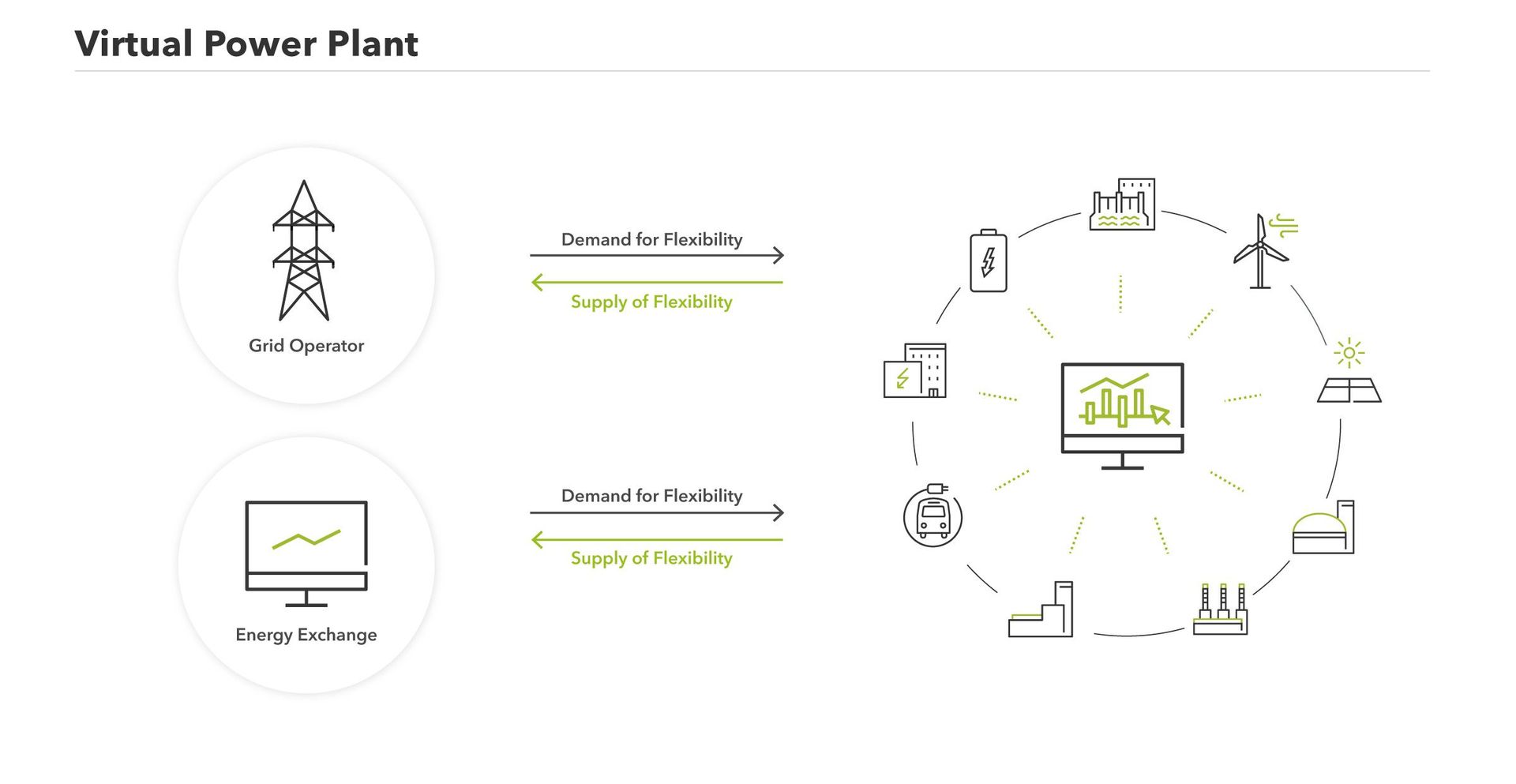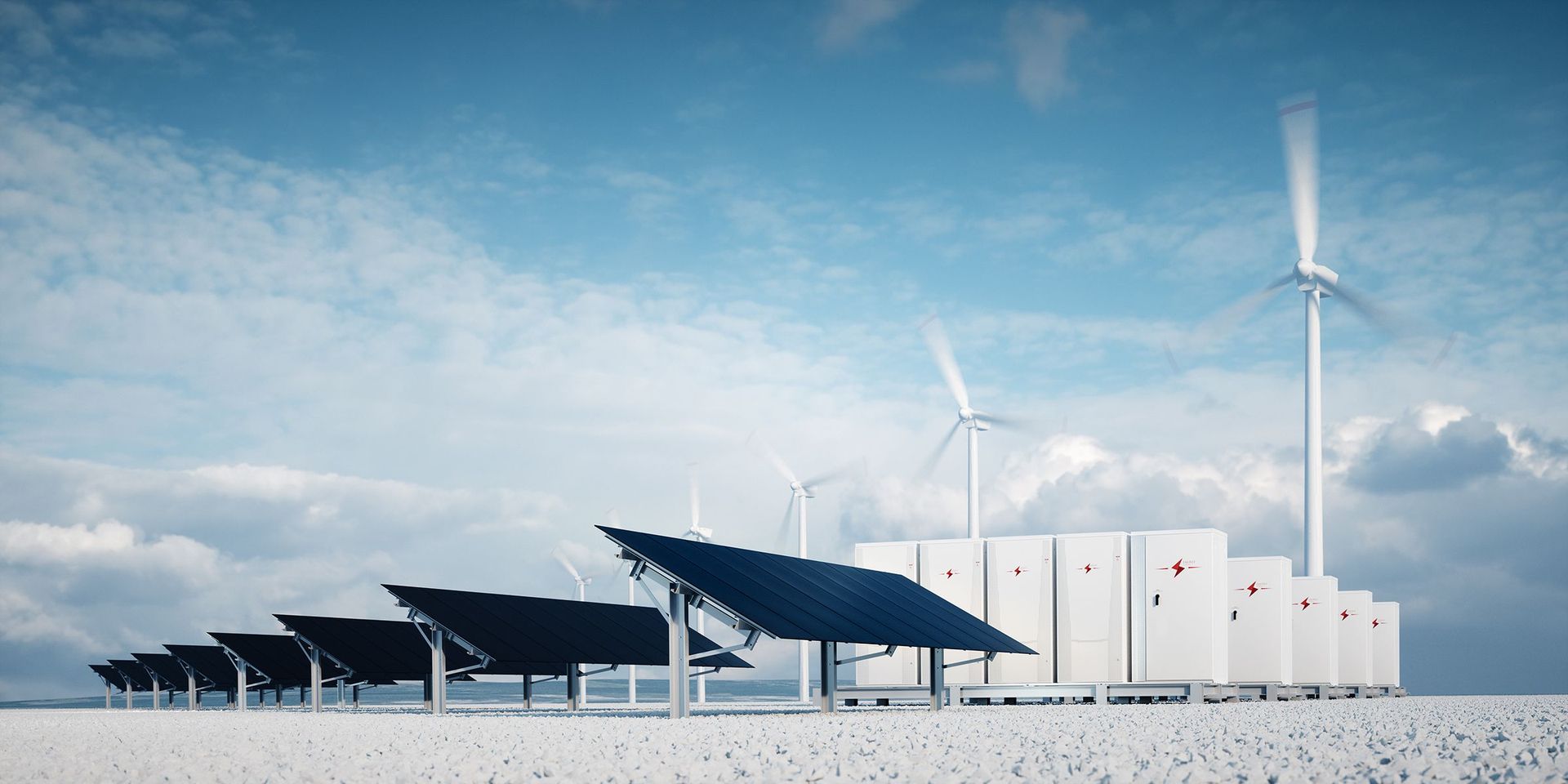What is a Virtual Power Plant?
Definition
In a Virtual Power Plant, decentralized units in a power network are linked and operated by a single, centralized control system. Those units can be either power producers (e.g. wind, biogas, solar, CHP, or hydro power plants), power storage units, power consumers or power-to-X plants (such as power-to-heat and power-to-gas). When integrated into a Virtual Power Plant, the power and flexibility of the aggregated assets can be traded collectively. Thus, even small units get access to the lucrative markets (like the market for balancing reserve) that they would not be able to enter individually. Any decentralized unit that consumes, stores, or produces electricity can become a part of a Virtual Power Plant.
Additionally to operating every individual asset in the Virtual Power Plant, the central control system uses a special algorithm to adjust to balancing reserve commands from transmission system operators and to grid conditions – just as a larger, conventional power plant does. Furthermore, the Virtual Power Plant can react quickly and efficiently when it comes to trading electricity, thus adjusting plant operations according to price signals from the power exchanges.
The market changes, the powerplants have to follow: Global energy markets are facing major changes. We move from a model with centralized electricity generation in power plants operated by large utilities towards a mix of decentralized and often renewable energy production in small facilities. Those small scale plants are typically owned by small companies or households, who become ‘prosumers’: consumer and producer at the same time.
We experience a true paradigm shift. The further penetration of renewable energy generation challenges the conventional way of operating our electricity system. Business models have to be reinvented and our grids redesigned. The variability of renewable sources like sun and wind do not necessarily endanger the system balance as long as they are dealt with appropriately. And that is exactly where a Virtual Power Plant (VPP) comes in.
Table of Contents
- Single assets forming a swarm of power plants
- Decentralized units create collective intelligence
- VPPs bring flexibility into power markets
- The price for electricity is not always the same
- Interface and network connection in a Virtual Power Plant
- Balancing reserve delivered by Virtual Power Plants
- Power consumers in Virtual Power Plants
- The hope for Smart Meters on the horizon
- Digitalization of the energy sector by Virtual Power Plants
Single assets forming a swarm of power plants
One single unit cannot transition our energy system single-handedly. But joining forces, renewable energy producers can really make a change. At the end of the 1990s, a time when the power markets started to liberalize, the first concepts for Virtual Power Plants were born – but mostly only in theory. Computer and network technology at the time and the prevailing regulatory conditions were not yet well suited for projects to take shape at the necessary scale for a systemic and economic development of a Virtual Power Plant.
Two events occurred in 2010, though, that helped make Virtual Power Plants become reality. Firstly, computer technology had improved substantially, opening the door for a readily available, high-performance control system operating in real time. Secondly, the German government announced the country’s exit from nuclear power together with new structures for the energy market, and modified the Renewable Energy Act. These changes provided the economic and legal foundation for Germany’s energy transition: The time for Virtual Power Plants had come.
Decentralized units create collective intelligence
A virtual power plant is a pool of several small- and medium scale installations, either consuming or producing electricity. Individual small plants can in general not offer services as balancing reserve or offer their flexibility on the power exchanges as their production or consumption profile varies strongly, they have insufficient availability due to unforeseen outages or they simply do not meet the minimum bid size of the markets. In addition, there are strict requirements regarding the availability and reliability of the flexibility offered in the market. To overcome these barriers, the solution is simple: work together! The combination of several types of flexible production and consumption units, controlled by a central intelligent system, is the core idea behind a Virtual Power Plant. This way, a VPP can deliver the same service and trade on the same markets as large central power plants or industrial consumers.

Virtual Power Plants can reach a total capacity equal to one or several nuclear power plants, though due to the volatility of renewable energy sources it changes constantly. If the wind isn’t blowing or the sun isn’t shining, solar and wind assets contribute less to the Virtual Power Plant. Combining a variety of energy sources in the VPP’s portfolio is vital in order to prevent uneven power balance. Due to the grid’s limited storage capacity, only about the same amount of power as is being consumed can be fed into the grid (within a certain tolerance). Assets integrated into a VPP can be power producers, power storage units, power consumers, and power-to-X plants, such as power-to-head and power-to-gas. Some of these units are due to their flexibility especially valuable to the portfolio: The flexible assets can compensate for variations in power feed-in caused by a lack of wind or a set of clouds – in both negative as positive directions.
VPPs bring flexibility into power markets
The flexibility, meaning the quick and versatile ability to balance the grid, is among the greatest strengths of Virtual Power Plants and their most notable difference compared to conventional power plants. VPPs can utilize the aggregated power to react to changes of the electricity price on the exchanges, quickly adapting to the existing supply of power in the grid, and thus execute trades. After all, the price of electricity changes constantly, up to 96 times per day in intraday trading on power exchanges. A price difference of two or even three digits per megawatt hour is no surprise here.
The price for electricity is not always the same
Big power plants with a consistent output of several hundred megawatts reach their technical limitations relatively quickly. You can picture a lignite power plant like an aircraft carrier: It needs a certain distance until the breaks fully kick in, meaning that it takes quite some time until the plant’s turbines are slowed down enough to accommodate an increased wind power feed-in during a storm. The climate-neutral wind power would instead be taken off the grid, though, to prevent the grid from overloading.
A Virtual Power Plant, per contra, would simply reduce the output of connected hydro and biogas plants to react to a surplus of wind power. And if there’s too little power on the grid, the control system can increase hydro power or biogas plant power production. Thus, the VPP promptly balances fluctuation in power production in real time without straining the public grid. To submit the commands that lower or raise feed-in amounts, the control system uses an API or remote-control units installed on each asset.
Interface and network connection in a Virtual Power Plant
The Virtual Power Plant uses a secure, tunneled data connection to transmit commands and data between the redundantly designed and highly secure control system and the individual assets. Even though these tunneled connections do use the public communication infrastructure, there are protocols in place separating information pertaining to the VPP from the general data flow. Buzzwords such as “the internet of things,” “industry 4.0”, and “M2M” might come to mind, but it really refers to a specially secured and shielded mobile and hard-wired data connection.
The bidirectional connection between the Virtual Power Plant and each asset not only facilitates the execution of commands, but it also enables a real-time, permanent exchange of data on the capacity of the networked assets and therefore the VPP as a whole. The data includes the reported feed-in capacity of solar and wind assets, consumption data, and storage capacity indicators, and thus is vital to a precise forecasting for operational planning of flexible power assets and power trading. The data is processed and evaluated automatically for the most part within the VPP’s software, which also takes on many of the tasks that are associated with initiating and executing trades on the power exchanges.
More information and services
Balancing reserve delivered by Virtual Power Plants
Renewable power producers such as biogas, cogeneration units (CHP), hydro, and emergency power generators are flexible and therefore have one additional advantage: They cannot only reduce or cease power production when there is a surplus on the grid (i.e. negative balancing reserve), but also feed-in additional power to the grid when there are electricity shortfalls (i.e. positive balancing reserve).
In order to provide balancing reserve, an asset must have a capacity of at least one megawatt. Several assets can be linked together in a Virtual Power Plant to reach this threshold. Thus, the cluster of assets responds to balancing reserve controls by the Transmission System Operator (TSO) collectively, sharing the profits among all asset operators. Power consumers can furthermore provide negative balancing reserve: For instance, an industrial plant that is part of a VPP can receive the command to increase production and thereby remove surplus power from the grid.
Power consumers in Virtual Power Plants
Industrial and commercial power consumers can profit from price signals coming from the power exchanges thanks to the data collected in the Virtual Power Plant. They can limit their power consumption to times when electricity is readily-available on the market and therefore cheap – in total, companies can thus reduce their power costs by up to a third.
This consumption optimization can be fully automated by the Virtual Power Plant, if desired. The VPP’s control system then sends commands to the company’s machine control room, complying with the individual restrictions, of course, and only intervening as much as needed. A power meter with consumption metering is required for this, though, and they are only available to consumers with an expected power consumption that exceeds 100,000 kWh annually.
The hope for Smart Meters on the horizon
Private households in Germany and other countries are far from reaching this level of power consumption. Their integration into Virtual Power Plants therefore will have to wait until smart meters are a standard part of every home. Smart meters will hopefully soon replace the old three-phase meters of the 1920s – roughly a hundred years after those were introduced. When the usage of appliances such as ovens, heaters, refrigerators, washing machines, and hot water heaters can be optimized intelligently in order to align with low electricity prices, power consumption can become more cost-efficient at home, too.
Digitalization of the energy sector by Virtual Power Plants
The energy sector is no exception when it comes to the fact that the future is digital. The supply of electricity is – like many areas of our society – undergoing a fundamental shift, not only on a national, but also on a global scale. We are finally moving away from large and fossil-fueled power plants towards smaller and decentralized units that are linked together through the opportunities of digitalization – and those are constantly expanding.
Similar to car sharing services without a car fleet and hotel booking platforms that do not own hotels, Virtual Power Plants are agents of a democratic shift in power supply: Responsibility is shifted back to society. VPP operators don’t own power plants; they just optimize the way in which every linked asset – still owned by a third party – is used. In doing so, today’s largest Virtual Power Plants have already exceeded the aggregated capacity of the largest nuclear power plants by far, and in the process, they produce climate-neutral power from the networked assets and address challenges that the power markets will face soon.
These challenges include the rising numbers of electric vehicles in the transportation sector and the number of network hubs and computer centers in response to digitalization, which is growing exponentially – and they all require huge amounts of electricity. With conventional power supplies and/or a single source of power, these demands cannot be met in accordance with climate protection goals. The hybrid and decentralized approach of a Virtual Power Plant, which utilizes a wide range of technology and energy sources, is a vital tool that will shape the energy landscape of the future.
Disclaimer: Next Kraftwerke does not take any responsibility for the completeness, accuracy and actuality of the information provided. This article is for information purposes only and does not replace individual legal advice.


